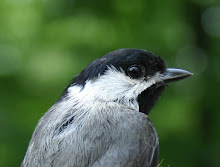Sometimes I don't realize how neurotic I am until I stop in the middle of the very thing I'm doing that makes me crazy to notice that it makes me crazy and I had that very thing happen this morning. We have had over a week of bone chilling, teeth chattering, cold weather and I have been worrying about keeping the birds outside fed.
We've discussed my Christmas ornament issues, and for those who weren't already aware, the flu season unleashes my germaphobe, hand washing idiosyncrasy (although I'm fairly certain those in the healthcare field would tell me I'm not crazy with all the hand washing). But perhaps the icing on the neurotic cake is my compulsion to keep the bird feeders full during those cold days when the thermometer hovers around the freezing mark.
The fretting doesn't begin until the forecast calls for highs in the mid-30s. Then I begin thinking about the birds in the neighborhood, most of which are insect and seed eaters. The worry kicks into overdrive when I think of the majority of insects that are dead and those few that aren't dead are in diapause and safely overwintering in some remote spot far from the reach of hungry beaks. My thoughts travel to the neighborhood gardens and how the seed supply must be pretty low or nonexistent at this point. Then I think about how much energy it takes for a bird to function during the day and survive a cold night. For example, did you know on a cold winter's night, a Black-capped Chickadee can lose up to 10% of it's body weight? That's OVERNIGHT people. So each day, that tiny bird must eat that much to compensate for what it lost overnight.
This is the point when I try my best to cater to the eating habits of my feathered friends. For example, Dark-eyed Juncos and White-throated Sparrows are exclusive ground feeders, meaning they will not fly up and eat from a feeder. They will only eat what is on the ground. Cardinals, Blue Jays and most Woodpeckers do not like tube feeders and their tiny perches (well, they're also too big for them as well). American Goldfinches strongly prefer thistle over other types of seeds (although I have seen them eat sunflower seed in very cold conditions). Black oil sunflower seed, peanuts and suet are high in fat which is important for the birds during the winter so I keep a steady stock. Woe is me if I let the supply run out and I see a huge flock of hungry birds pecking at seed crumbs in the feeders.
Every morning I go outside and fill a big feeder with a sunflower seed mix, throw out a few millet sprigs on the ground, check the suet and thistle feeders before tackling the peanut feeder (Picture of this feeder is in this entry). The Blue Jays have a habit of pecking the peanuts to get at the meat and leave the empty shell in the feeder. So I have to throw out the peanut shells before filling the feeder with fresh peanuts.
My neurosis is worst after it snows. All that seed under a layer of snow and/or ice. How are my ground feeding birds going to eat?? That's when I make it a point to scatter seeds on the window ledges and on the steps just outside the sliding glass door. Yes dear readers, I am that crazy. You may wonder what the payback is from all this fretting and feeding and for the non bird lovers, I'm sure it's difficult to understand. But I love watching the Blue Jays swoop down on the peanut feeder and make exaggerated pecking motions as they work to get their food. I enjoy listening to the chips and off-key tune of the White-throated Sparrows. And it's amazing to see at least a dozen or more Cardinals scattered through the yard.
I also like to think I'm contributing somewhat to the survivability of these birds during a time when some of these species struggle to compete for space with habitat fragmentation and urbanization. They need all the help they can get.
I know I'm a worrywart, but I figure this is a productive thing to worry about. I worry, I fill the feeders and the worry disappears...until the feeders are empty or it snows. Then we repeat the cycle.
Cheer
10 hours ago

No comments:
Post a Comment